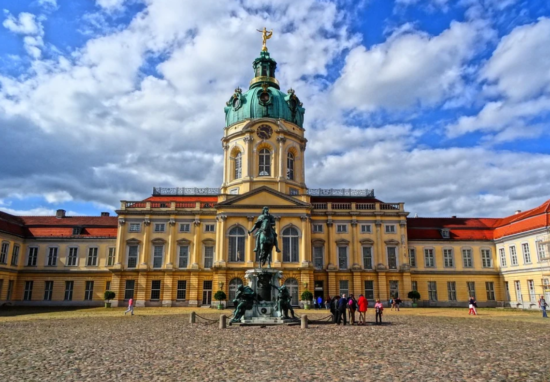Charlottenburg Palace
Charlottenburg Palace is – with the Old Palace and the New Wing – the largest and most significant palace complex in Berlin. It has served as the home of former Brandenburg electors, Prussian kings, and German emperors. It was among the favorite retreats of seven generations of Hohenzollern rulers, who repeatedly redesigned individual rooms with luxurious interior décor while also having sections of the gardens transformed into royal grandeur.
Today, the shifting tastes of the palace’s many residents and the changing requirements for ceremonial and private use can be traced from the Baroque period to the early 20th century. Following severe damage in World War II, the palace was largely rebuilt and refurnished. The former summer residence is now one of the most important attractions in the German capital.


The palace offers interiors and halls whose arrangements are faithful to the originals, impressive suites, and exceptional art collections of outstanding masterpieces. The Porcelain Cabinet, the Palace Chapel, and the bedchamber of Frederick I are among the highlights of the magnificent Baroque parade apartments in the Old Palace that had been built in 1700 with its crowning towers.
This construction of the central structure of the large palace complex was commissioned by the clever and art-loving Queen Sophia Charlotte and her husband Frederick I.


An exceptional presentation at Charlottenburg Palace displays rare pieces from the Hohenzollern silver collection and Frederick the Great’s renowned snuffboxes. Together with the royal apartments and their art treasures, nearly 600 precious objects offer insights into additional facets of Prussian court culture, while allowing visitors to enter the glittering world of the royal household.
The selection of historical tableware made of gold, silver, and porcelain, unrivaled in its extent and cultural-historical importance, was formerly kept in the Silver Vault. The new exhibition presents the tableware both as finely set table arrangements or shown on decorative buffets. Around one hundred royal dinner services have been preserved, some in their entirety, delighting visitors with their richness of color and form. The composition and designs of the services reflect the prevailing taste, the particular culinary preferences, and the ceremonial customs of the courtly table between the periods of Baroque and Historicism.


Frederick the Great’s snuffboxes, made of semi-precious stones, mounted in gold and set with diamonds, represent valuable items of an entirely different kind. The king, who otherwise shunned the court’s traditional luxury, owned an exquisite collection of valuable snuffboxes, which he always liked to have close at hand. Eight of these very beautifully designed precious objects are on display in the permanent exhibition, The Silver Vault. Description by https://www.spsg.de/en/palaces-gardens/object/charlottenburg-palace-old-palace/

